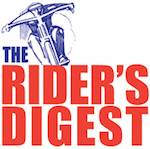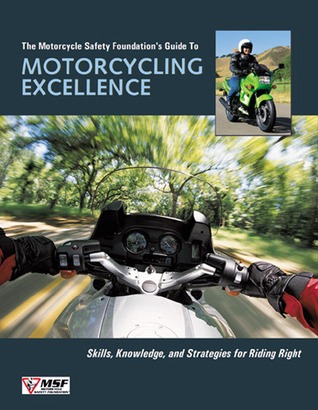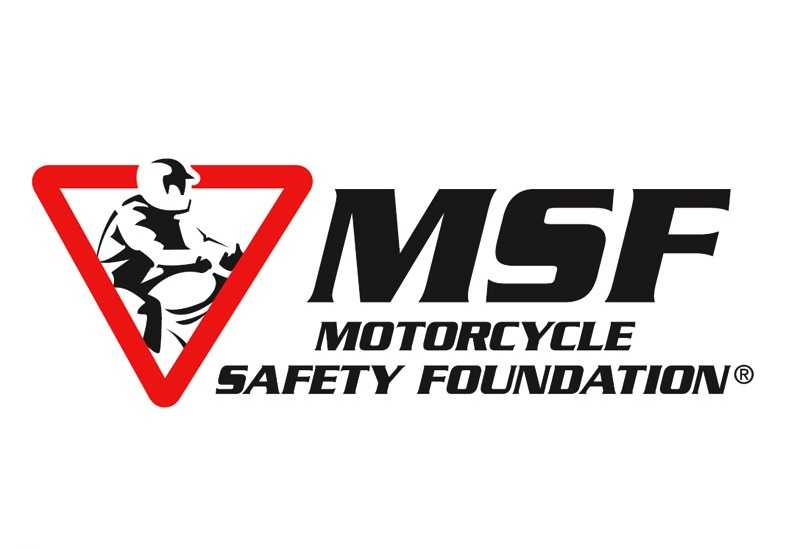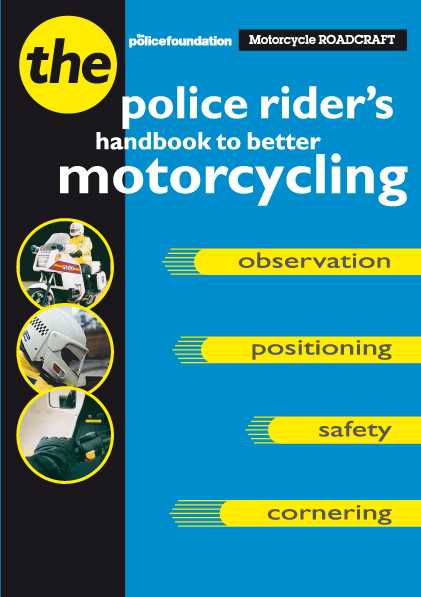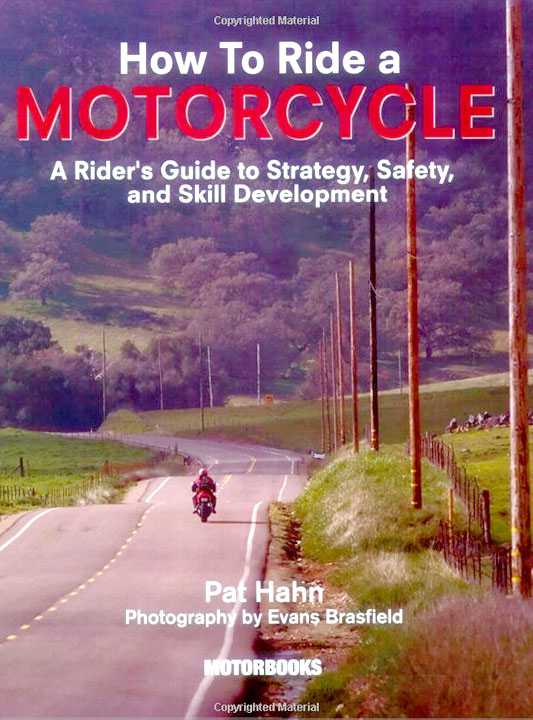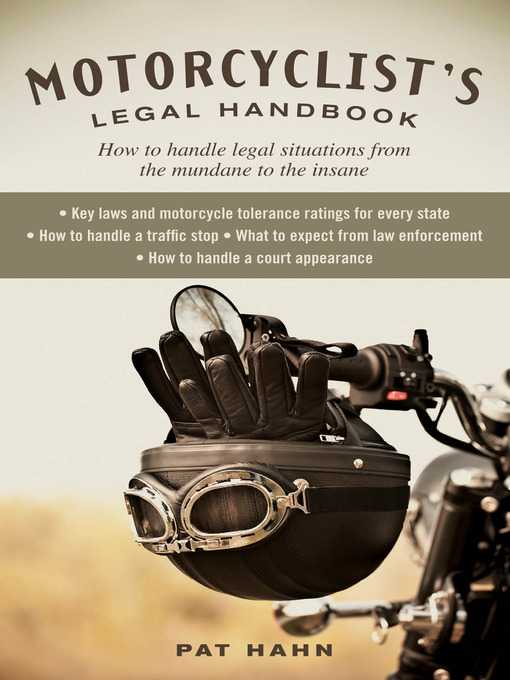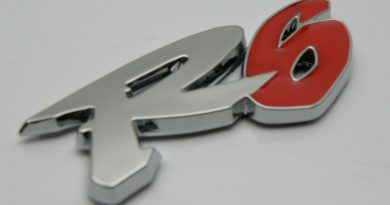Book Review – Riders and Roadcraft (Part II)
Whenever I examine a book about riding motorcycles, the image of a beginning rider with the book resting on the handlebars comes to mind. When the rider comes to the next problem, he or she tries to stop, look up the answer, and proceed, but can’t, with the obvious humorous results, all suitable for the next male menopause comedy, if that bit of business hasn’t been used already.
Of course, the book is one that focuses on the actual riding of motorcycles and not all the other secondary and tertiary considerations. Or as Darwin Holmstrom says in the forward to Pat Hahn’s How To Ride a Motorcycle: A Rider’s Guide to Strategy, Safety, and Skill Development, “A few years back I wrote a book called The Complete Idiot’s Guide to Motorcycles which contained a section on how to ride a motorcycle. Because that was just one section in a very large book, it only covered riding basics in the broadest strokes possible. I found this to be a necessary evil when trying to cram information on every aspect of motorcycling into one volume.”
Holmstrom, like so many others facing the same practical issue, ultimately defers to the Motorcycle Safety Foundation (MSF) and the series of courses it offers. Unlike the art and skill of riding, the other aspects of motorcycling date fast. Because the books this month cover riding in all its aspects and little else, they are less prone to obsolescence, necessary evils, or the charms of nostalgia.
The classic in the UK is Motorcycle Roadcraft: The Police Rider’s Handbook to Better Motorcycling, produced under the auspices of The Police Foundation. The author of record is Philip Coyne.
Roadcraft is written in a vigorous, repetitive style. Repetition and reiteration drive lessons about braking and acceleration, signals and cornering, overtaking and positioning home again and again. Most people who’ve used it seem to be fond of its lessons on one level or another.
The Rider’s Digest’s editor Dave Gurman’s favorite Roadcraft watchwords are “a speed that is safe for the conditions”. It turns up at the beginning as “Good riding requires you ride at a speed that is safe for the conditions” and amplified at the end as “Riding safely at speed depends above all else on adapting your speed to the circumstances”.
My favorite is “You must always be able to stop within the distance you can see to be clear”. By the end of the book this morphs into “Ride so that you are able to stop safely on your own side of the road in the distance you can see to be clear”.
The differing take-aways have more to do with our differing personalities than any intent on the part of Roadcraft. There is considerable overlap between the two. The book notes, “It ensures that you observe the riding safety rule of matching your speed to your ability to stop within the distance you can see to be clear”.
Roadcraft is about more than just maintaining speed and distance. It provides a method for the police to ride safely and effectively. The basic checklist this “system of motorcycle control” is information-position-speed-gear-acceleration as an endless loop of action (gathering and processing relevant information) and reaction (speeding up, slowing down, turning, stopping, etc.). Some items on the list have checklists of their own. Information, for example, has the acronym TUG – take, use, give – to help gather the information a rider might need.
The book also provides mnemonics for checklists to the side of the main topic. POWER – petrol, oil, water, electrics, rubber (tyres) – turns out to be the British equivalent of T-CLOCS – tires and wheels, controls, lights and electrics, oil and other fluids, chassis and chain, stands (side or center). That the British emphasize checking petrol while the Americans emphasize checking the side stand may or may not reflect any differences between the two cultures. Parenthetically, fuel is at the bottom of the list of “other fluids”.
Roadcraft goes through how the five-point method is applied to each basic riding maneuver as well as such special circumstances as weather and road hazards. The objective is that the police rider should be able to respond to emergencies as well as get home alive and in one piece.
To be blunt: this is a great book. It’s meant to be read in sections, not straight through (as I did), but survives that abuse. The explanations are clear and the diagrams useful. If nothing else I now know how to make right and left turns while driving on the “wrong” side of the road, the thought of which I’ve always found intimidating. And I shall always cherish it for the following bit of advice when overtaking a vehicle while riding a motorcycle: “Avoid startling horses”. Exactly how many horse-drawn vehicles are there in the UK?
The rough equivalent to Roadcraft in the US is The Motorcycle Safety Foundation’s Guide to Motorcycling Excellence. The book is meant to supplement the MSF’s basic riding courses, which are offered around the country. According to the website (www.msf-usa.org), the MSF was founded in 1974 and is a national not-for-profit organization sponsored by BMW, BRP, Harley-Davidson, Honda, Kawasaki, KTM, Piaggio, Suzuki, Triumph, Victory, and Yamaha. In addition to offering its curriculum of riding courses, it conducts safety research and lobbies the US government on behalf of the industry.
The result is problematic because it is a rare case of industry doing something right and not just being self-serving. Let’s start with “rare” and “problematic” which are examples of what some call the academic waffle. In academia is it vulgar – well – inappropriate – to assert, say, grass is green. Grass seems to be green. And grass only seems to be green subject to further research. Grass can’t even just be green if it’s to the side of the main point. If the study is about lawnmowers, whether grass is green or not is beyond the scope of the inquiry.
It is not only a rare case, but also the only case of privatizing what should be under the control of the government that works that I know of. The larger issue isn’t whether it’s done well, but rather whether it should be done at all. Suspicion is justified in a world where a lack of independent banking and investing regulation has plunged Europe and North America into an economic depression and privatizing prisons to profit making organizations has resulted in lawsuits and human rights violations.
Why is motorcycling the exception? By and large, the industry is still run by a “bunch of like-minded idiots”: people who care about motorcycles almost as much as they care about profits. But those with memories long enough to recall Harley-Davidson’s adventures with AMF or the conglomeration of the final handful of British marques may wonder how long is this state of grace going to last.
While it lasts, the MSF offers a fine array of classes and this text to its Basic Riding Course. Chapters cover basic skills, street strategies, and special situations. Cornering and counter-steering get turns, as does gear and troubleshooting. Between chapters such motorcycling experts and celebrities as Keith Code, Erik Buell, and Reg Pridmore contribute sections on their specialties. I particularly liked Code’s essay on why counter-steering is not counterintuitive, contrary to popular rumor.
Motorcycling Excellence is upfront about what it wants to do. In the Acknowledgments it states its “Key Messages” are: “Get trained and licensed; Wear protective gear – all the gear, all the time – including a helmet manufactured to the standards set by the DOT; Ride unimpaired by alcohol or other drugs; Ride within your own skill limits; [and] be a lifelong learner by taking refresher rider courses”. And that’s just about the order the topics are covered.
The prose style ranges between workmanlike and appropriate: very corporate. Personality is left to the celebrity sections. At least a third of the book focuses on safety issues, from gear to motorcycle maintenance to “riding straight”. When it comes to riding under the influence of various legal or illegal substances, the MSF is somewhere to the extreme right of the Temperance Union.
But in the end it is an industry publication. While the courses are great and include such neat perks for successful students as reduced insurance rates and in some cases an automatic motorcycle endorsement, the MSF is ultimately about selling products and services. Not only are the MSF courses pitched at every opportunity – at least three in the first 40 pages alone – but also Appendix A is effectively a sales brochure for the program. It certainly looks and reads like a reprint of one.
Original photography frequently features women as motorcyclists, which is unusual if not unique. But then again, the motorcycle industry has identified women as a target niche market. That potential customers are more likely to buy if they see someone “like them” in the advertising is an accepted truism in marketing. Apparently seniors – another niche the industry has identified as a growth sector – aren’t as photogenic, though a handful of pictures featuring old coots are included. And the visible and invisible minorities – racial and religious respectively – don’t seem to be seen to have been identified as being as potentially lucrative. Of course, it is difficult to tell what someone’s race, creed, color, sex, or sexual preference is when he or she is wearing full safety gear.
To be fair, it’s easy enough to ignore the politics. On the obnoxious scale, Motorcycling Excellence is at the low end of the middle range. Then again, what sane person would want to learn to ride and then not ride? Yes, motorcycles can be rented, but the more rational and cost effective solution is simply to buy one. That’s one and not two as recommended by Nick Ienatsch in his sidebar “Your First Motorcycle”. Regardless, the book is a recommended adjunct to the course in particular as well as a good reference work to keep in general.
If a course and a text book aren’t enough, there’s Hahn’s How to Ride a Motorcycle, which is a casual study guide to both. Hahn also produced Motorcyclist’s Legal Handbook, which is the more interesting volume of the two. The forward is by Holmstrom, who, in addition to having edited one of Hahn’s earlier books, is not only thanked in the acknowledgments in this one, but also gets his Idiot’s Guide listed as recommended reading at the end of the second chapter. There is nothing improper here. It just looks funny.
Hahn wants riders to take motorcycling seriously and believes the best way to do that is with humor. There is nothing wrong with that approach. I’ve used it myself when delivering the odd paper or lecture over the years. His basic advice can be taken seriously enough: buy the best gear one can afford; take the MSF course; and ride all the time. In Hahn’s opinion the more time a rider spends in the motorcycle mindset as he calls it, the better rider he or she will become. He wants motorcyclists to ride to work, ride to play, ride to visit the parents, ride to run the weekly errands. He even provides a series of suggested practice exercises to help readers become better riders, as indeed a study guide should.
The motorcycle mindset is made up of the three attitudes toward safe riding: the rider is responsible for everything that happens on the road; all other drivers and vehicles are out to kill the rider; and the road is designed to make the rider crash. No, he’s not being funny about that last point. I live in New York. Few who live here would argue otherwise. And Hahn does distinguish between what will keep the rider safe from what the legal or moral issues might be.
The main reason for rider accidents – sorry: rider irresponsibility – is Motorcyclist Information Overload (MIO). MIO is when the rider has to process too much information in too short a piece of time to react appropriately to rapidly shifting circumstances. Hahn clearly wouldn’t disagree with the watchwords of Roadcraft.
Where Hahn does disagree with Roadcraft – as well as Motorcycling Excellence – is in tone or approach. He doesn’t believe that the neutral corporate tone of those two books is the most effective way to engage the novice rider. Hahn believes in using humor and speaking the rider’s language. And this is where he goes down, all due to SIO – Stylistic Information Overload.
He begins his attempts at style by using the analogy of an iceberg to convey the idea of deeper and deeper levels of motorcycling competency. An onion or a matryoshka doll might be a better metaphor, but it turns out at the end of the book that he actually has something else in mind, making all three choices irrelevant. The iceberg is at least the right shape.
Hahn’s avowed purpose with the iceberg is to highlight the differences between a poser and a real rider. He means poseur. The spelling was quite the poser to me so I looked it up. Poser has citations, but it has yet to be accepted or preferred. Poser seems to be the sort of streamlined spelling for which the texting generation can be thanked.
Back to the iceberg. Poseurs, or rather posers, are at the apex of the iceberg reflecting how little they know. Riders, especially those with ten or more years in the saddle, are at the bottom, well below sea level, reflecting the depth and breadth of their knowledge. The middle’s a muddle, but Hahn ignores it in favor of risking the fallacy of false alternatives. Motorcyclists are either posers or riders.
Posers only dress the part, according to Hahn. They do not ride well, if they ride at all, or they are just “fair-weather” riders. They trailer their bikes to go somewhere, but will ride the last 50 miles to look and feel like they rode there. Apparently Hahn has never considered transporting rare and fragile antique and vintage motorcycles which are routinely trailered. Even a run of five miles could be risky for certain one-hundred-year-old retro rockets (as I like to call them).
Posers pose other problems for Hahn. He believes that is the posers, who drive up the costs of motorcycling, from the bikes to the insurance as well as keeping purveyors of expensive accessories in business. Right. No regular rider – never mind a real rider – has ever bought an expensive accessory – a good full-face helmet, say – or contributed his or her fair share to motorcycling statistics.
If that’s not enough, Hahn feels that posers are the equivalent of tourists. To be fair, he may be unaware of the wide variety of package tours geared specifically for motorcyclists, many requiring quite an advanced set of riding skills. The offerings put the tourer into tourist, or perhaps the tourist on the tourer. As for the tourist in question, she or he has managed to leave home and television set behind and actually go somewhere. Next time it might be on his or her own.
Poser isn’t the only word choice Hahn makes that a more seasoned or professional writer might resist. Transportationalist is another. He puts it in opposition to hedonist. The hedonist is a rider (real, I presume, not fake), while the transportationalist is someone who uses other methods to get from one place to another. It does not, as one might expect, have anything to do with transporting British convicts first to the American colonies and later to the Australians ones. The version of the term more common in the Commonwealth is anti-transportationalism, which was the movement opposing penal colonies. Here it is a coincidental neologism, presumably American, examining transportation networks as local ecologies. Such ecologies would include motorcycles as they do bicycles. The ones who do the examining are called transportationalists. It does not refer to conventional commuters.
Another curious authorial judgment call is a caption on page 15. The photograph is of two young men, presumably Hahn’s riding buddies. The caption reads in part “and yes, ladies, they’re both single”. The baby carriage in the background is probably a coincidence. He repeats the joke in another caption to another picture, making the whole sordid thing worse. First, this is rather condescending to women. Even if he flattened the playing field with a picture of a couple of female motorcycles captioned “yes, gentlemen, they’re both single”, it would be condescending. Second, pimping for one’s friends isn’t exactly savory.
At best rants about poseurs have an unfortunate frat boy/mean girl ring. It’s frequent among members of certain in-groups or sub-cultures – punk or Goth – to distinguish between those who are the real deal (i.e., the ranter in question) and those who just bought the tee-shirt (or fangs). More typically, the genuine fake is the person ranting about poseurs. That’s almost the case here. Hahn does not come across as a poseur in this book (or anywhere else) when it comes to riding; he does come across as a poseur in this book when it comes to writing. With four books to his credit, that’s hardly the case. But the attitude puts me off. If I had been reading How to Ride a Motorcycle personally, I doubt I would have bothered to finish the first chapter, assuming I managed to complete the introduction.
However, I was reading it professionally and had to read all the way through to the end of the last chapter. The book moves from bad to genuinely useful (as a study guide) to interesting. The material in the last chapter would have made a better introduction. Hahn it turns out has a vision of how people should progress through their lives as riders. It bears a strong echo of Abraham Maslow’s Hierarchy of Needs, which is usually presented as a pyramid diagram. Hahn sees riders going from novices who rise through levels of mastery and community until they reach the apex and then give back to motorcycling, by teaching the next generation of novices if nothing else. This also reflects the complicated master/disciple relationships prevalent in martial arts training (to which he suggestively makes reference in passing). Unfortunately he doesn’t pursue any of those ideas with anything like the vigor with which he applies to posers.
Recommended only for those who want a study guide for the MSF course and textbook. Much better and highly recommended is his other book, Motorcyclist’s Legal Handbook.
The Legal Handbook deals with that other hazard of motorcycling: the traffic cop. I own more than a thousand books about one aspect of motorcycling or another and easily have half as many on various wish lists (in case anyone has ever wondered what my qualifications are: I’ve actually been reading these books for years). I can’t think of another volume which even discusses the topic of traffic violations, tickets, and court appearances in any real depth, let alone completely dedicated to the topic. Hahn has found himself a niche.
The book covers all aspects of dealing with traffic tickets from the obvious – obey local laws – to the subtle – how to behave when the police pull you over. Hahn is all for fighting any and every traffic ticket and provides a sound defense for that approach (too many tickets can raise your insurance rates or lead to a suspension of your license). There is even a step by step guide about how to fight a ticket at each stage of the process. He extends some his points about aggressively riding defensively that he presented in How to Ride a Motorcycle.
Hahn’s basic message is to stay under the police’s radar screens both physically and metaphysically. Don’t ride at the speed limit; ride below it. Don’t “look funny”; wear proper safely gear and make sure all lights and like on the bike are in working order. That wearing a full helmet might keep you safe from encounters with the police may be a unique argument in its favor.
The second part of the book covers local traffic rules and regulations state by state. He also ranks the states on the basis of motorcycle rideability. The best is Montana; the worst, New Jersey. By the way, New York, where I live, is number 49, which is not a surprise, considering the density of the population, the age and condition of the roadways, and the fact that it’s New York.
I suspect any individual state’s ranking is going to be “not a surprise” to anyone who lives in that state. In my state (NY) my distinctly informal survey of reactions to the ranking indicated an even split between “Of course New York is better than New Jersey” and “What do you mean we’re only 49; we should be 50: I demand a recount”.
The book is also a casual argument in favor of the establishment of federal traffic legislation, which is probably not Hahn’s intent. Let’s say that I decide to stop reading motorcycle travel books – the bulk of the collection – long enough to take an actual trip of my own. Let’s say that I decide to trace the route of the old King’s Highway, a road that connected the original American colonies and was built on the order of Charles II in 1650.
Also known as the Road that Paved the Revolution, the 1300 mile highway connected Charleston, South Carolina, to Boston, Massachusetts. The highway has considerable historic and architectural interest, but the riding itself ranges from bad to boring. According to Hahn’s rideability index, the average rating for the 10 states is 41.5.
However, each state has its own traffic laws. Six states have helmet laws. Nine require eye protection. (The exception, North Carolina, does have a helmet law.) Daytime headlights are required – or at least not required – in nine states, but prohibited in one (Delaware). A rider can use both earplugs in five states, only one in three, and none in two (Massachusetts and Pennsylvania). Police enforcement is described as businesslike in nine states, but enthusiastic in one (Maryland).
Would the combination of a helmet, eye protection, no earplugs, and headlights keep the rider under police radar? Statistically, yes, but then there’s Delaware. I suspect out-of-town plates will boost businesslike up to enthusiastic. Essentially a rider has to go through the slapstick number of changing most if not everything every time he or she crosses a state line.
But laws change, and traffic laws are no exception. That means that the second part of the Legal Handbook will be out of date soon, if it’s not already, although the first part will remain valid for decades. It would be nice if the book were revised every year (or two). That’s unlikely, alas, due as much to the economy as to motorcyclists being somewhat second-class citizens in the States. Nevertheless, a copy is a useful acquisition to anyone who does or plans interstate or cross-country travel.
Jonathan Boorstein
